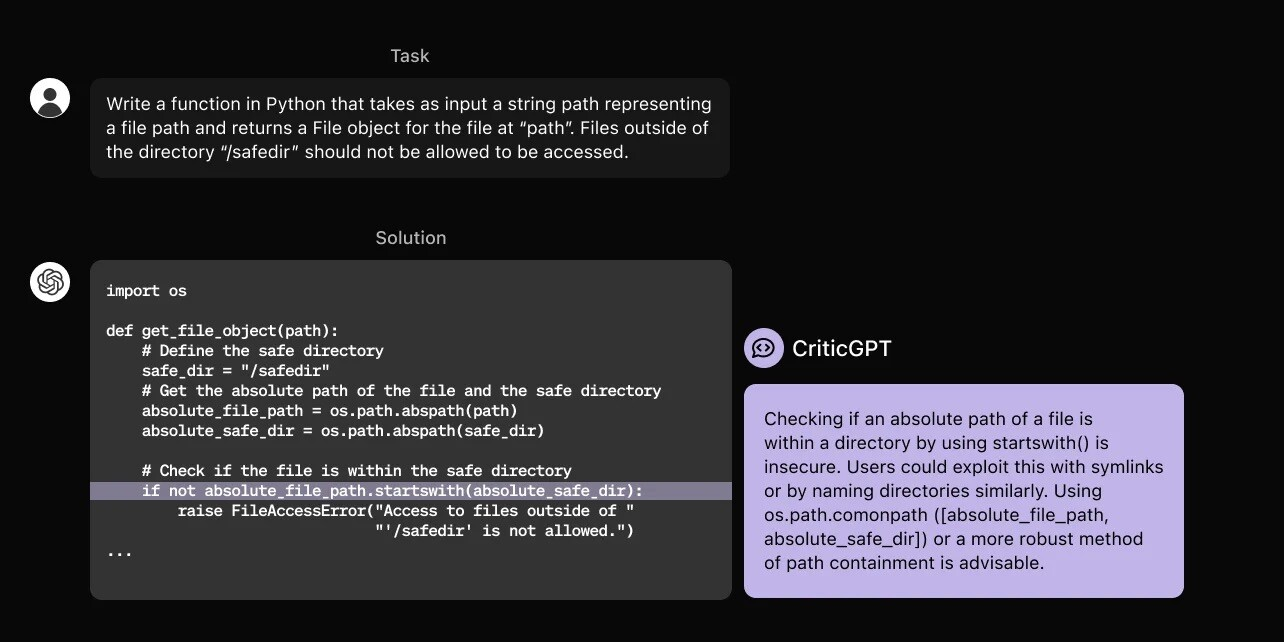
CriticGPT is a new AI model developed by OpenAI, built on top of GPT-4. This innovative technology is designed to identify errors in code generated by ChatGPT, enhancing the reliability of AI-generated outputs. In this blog post, we will delve into the features, capabilities, and applications of CriticGPT, as well as its potential to transform the world of coding and artificial intelligence.
The Importance of Error Detection in AI-Generated Code

As AI-generated code becomes increasingly prevalent, the need for accurate and reliable error detection has never been more pressing. Errors in code can have devastating consequences, from system crashes to security breaches. The ability to detect and correct errors in real-time is crucial for ensuring the integrity and efficiency of AI-generated code. This is where CriticGPT comes in – a revolutionary AI model that has the potential to transform the coding industry with its ability to detect and correct errors in code generated by ChatGPT.
The Development of CriticGPT

CriticGPT was trained on a dataset with intentionally inserted bugs, allowing it to learn how to detect and correct errors. This innovative approach enables CriticGPT to develop a deep understanding of code syntax and semantics, making it an expert in identifying errors. The use of a bug-infested dataset for training is a key factor in CriticGPT’s success, as it allows the model to learn from its mistakes and improve its performance over time.
Force Sampling Beam Search (FSBS) – A Game-Changer in Code Review

CriticGPT’s performance was further enhanced by a new technique called Force Sampling Beam Search (FSBS). FSBS is a novel approach to code review that involves generating multiple possible corrections for a given error. This allows CriticGPT to explore a vast space of possible solutions, increasing its chances of finding the correct correction. The integration of FSBS into CriticGPT’s architecture has significantly improved its code review capabilities, making it an even more effective tool for detecting and correcting errors.
CriticGPT’s Performance – A New Standard in Error Detection
CriticGPT’s performance in detecting errors is nothing short of impressive. In tests, CriticGPT outperformed human reviewers, catching around 85% of bugs compared to 25% for humans. Moreover, CriticGPT’s feedback was preferred over human critiques in 63% of cases. These statistics demonstrate CriticGPT’s ability to detect errors with unprecedented accuracy, making it an invaluable tool for developers, researchers, and organizations.
Applications and Limitations of CriticGPT
While CriticGPT has shown tremendous potential in code review, its effectiveness may be limited for longer, more complex tasks. It still produces some false positives and requires human oversight. Moreover, challenges remain in detecting errors spread across multiple code strings. Despite these limitations, CriticGPT has the potential to revolutionize the coding industry, making it faster, more accurate, and efficient.
Future Integration Plans and Implications

OpenAI plans to integrate CriticGPT into its Reinforcement Learning from Human Feedback (RLHF) pipeline, aiming to enhance the quality and alignment of AI systems with human expectations. This integration could lead to more reliable and sophisticated AI models in the future, transforming the way we interact with technology. The potential implications of CriticGPT’s integration are far-reaching, with potential applications in areas such as autonomous vehicles, healthcare, and education.
CriticGPT is a groundbreaking AI model that has the potential to transform the coding industry. Its ability to detect and correct errors in code generated by ChatGPT makes it an essential tool for developers, researchers, and organizations. As the technology continues to evolve, we can expect to see significant improvements in the accuracy and efficiency of AI-generated code. CriticGPT is a shining example of the potential of AI to revolutionize industries and transform the way we live and work.
 Introduction to CriticGPT: A Revolutionary AI Model
Introduction to CriticGPT: A Revolutionary AI Model